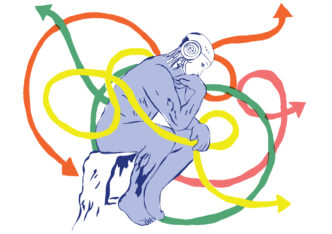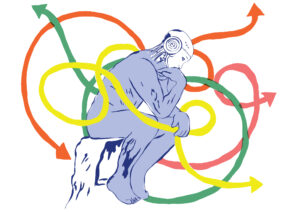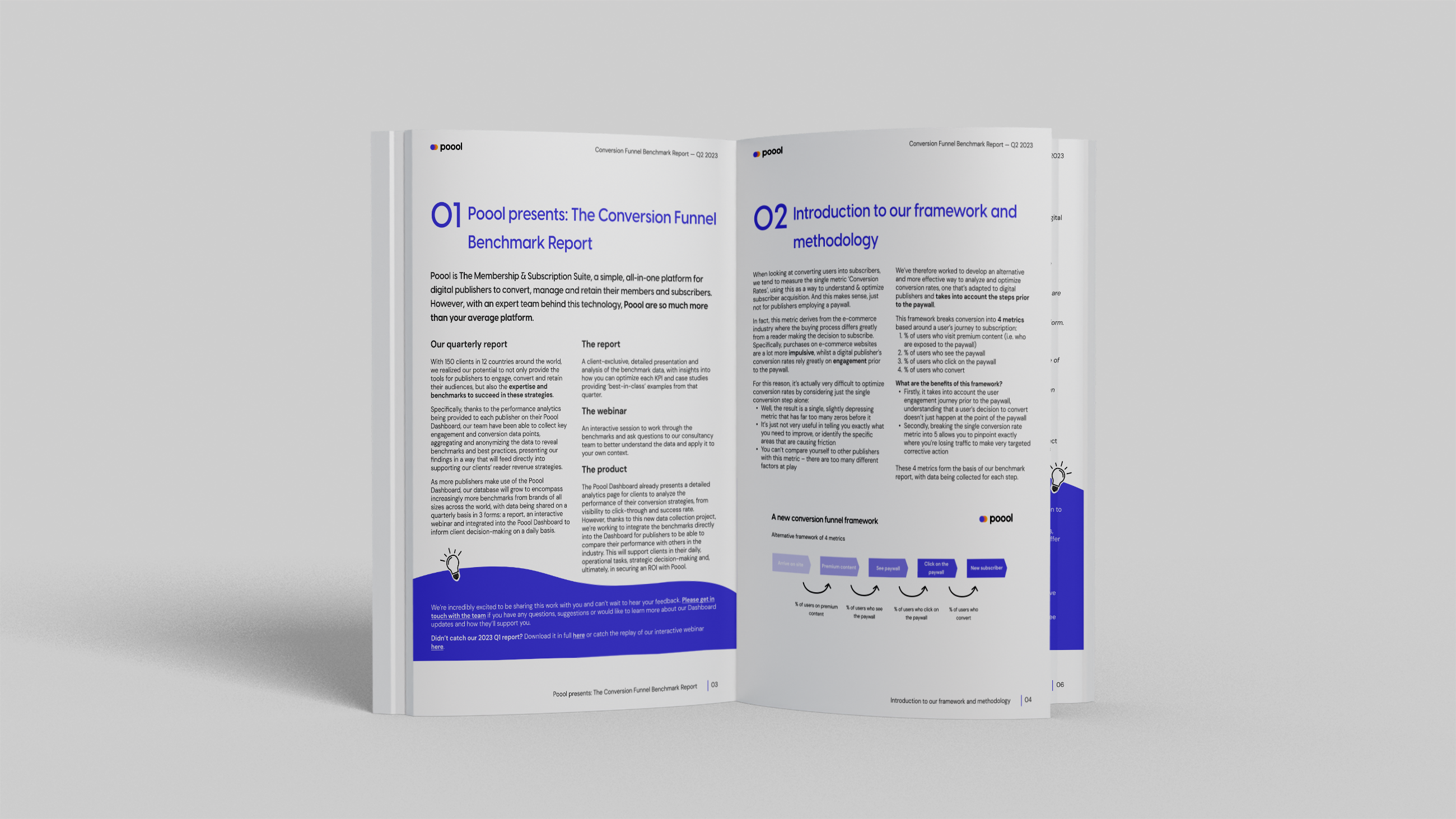

When looking at converting users into subscribers, we tend to measure the single metric ‘Conversion Rate’, using this as a way to understand & optimize subscriber acquisition. And this makes sense, just not for publishers employing a paywall.
In fact, this metric derives from the e-commerce industry where the buying process differs greatly from a reader making the decision to subscribe. Specifically, purchases on e-commerce websites are a lot more impulsive, whilst a digital publisher’s conversion rates rely greatly on engagement prior to the paywall.
For this reason, it’s actually very difficult to optimize conversion rates by considering just the single conversion step alone:
- Well, the result is a single, slightly depressing metric that has far too many zeros before it
- It’s just not very useful in telling you exactly what you need to improve, or identify the specific areas that are causing friction
- You can’t compare yourself to other publishers with this metric – there are too many different factors at play
We’ve therefore worked to develop an alternative and more effective way to analyze and optimize conversion rates, one that’s adapted to digital publishers and takes into account the steps prior to the paywall.
This framework breaks conversion into 4 metrics based around a user’s journey to subscription:
- % of users who visit premium content (i.e. who are exposed to the paywall)
- % of users who see the paywall
- % of users who click on the paywall
- % of users who convert
What are the benefits of this framework?
Firstly, it takes into account the user engagement journey prior to the paywall, understanding that a user’s decision to convert doesn’t just happen at the point of the paywall
Secondly, breaking the single conversion rate metric into 5 allows you to pinpoint exactly where you’re losing traffic to make very targeted corrective action
These 4 metrics form the basis of our benchmark report, with data being collected for each step every quarter.
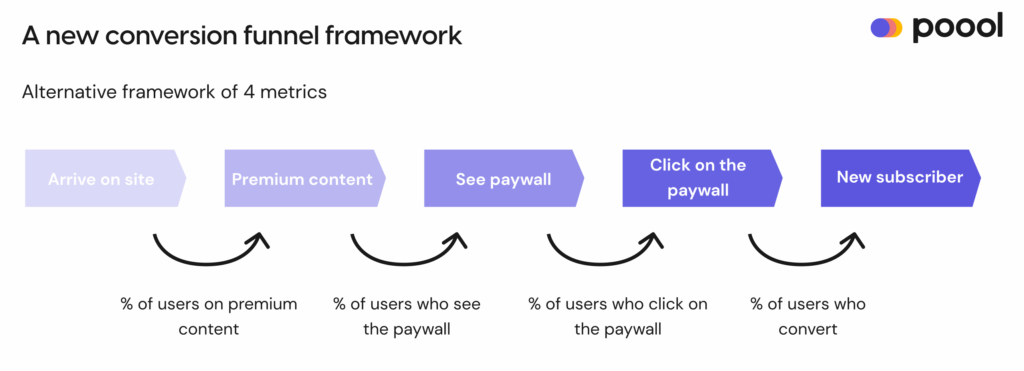
Download the full report here, exclusively for Poool clients, or find our summary of the key findings below. For data segmented by publisher-type, please contact your account manager as these results are reserved for Success clients only, those working with our team of expert consultants.
Step 1. Percentage of traffic on premium content
Def: How many users on your website visit premium content (vs free, unblocked content), where they have the potential of being exposed to the paywall?
Benchmark results Q2 2023:
Overall average: 56%
Range of results: 3%-97%
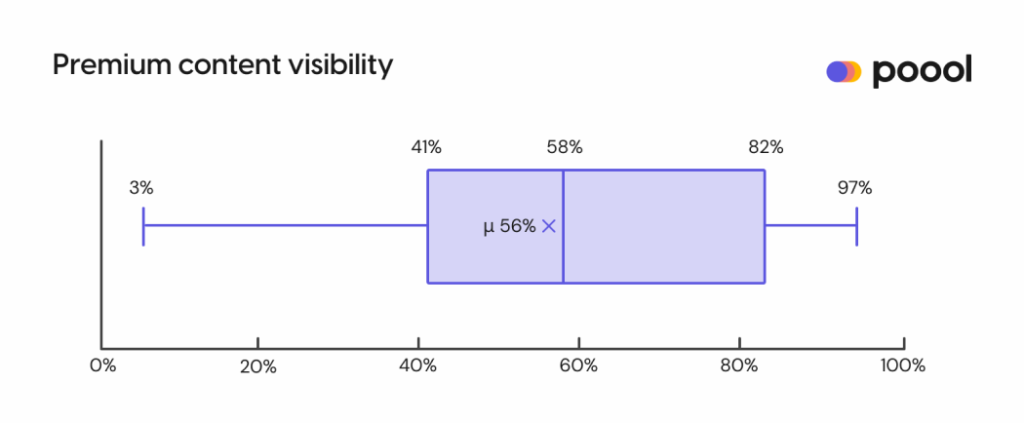
B2B media have the highest average percentage of traffic on premium content, at 75%, likely thanks to the combination of a smaller, more engaged audience and highly focused, niche content. The result is that blocking more content with a paywall won’t have a negative impact on engagement but will instead cause the right amount of frustration to convert. We can compare this to lifestyle publishers who lie at the other end of the scale, with an average of 27.81% of traffic on premium content. These media often publish a wide range of content and tend to have a very large, more volatile audience who are less likely to subscribe.
Note that there are 2 publishers at the lowest end of this range, at 3%, who have only just launched a premium model. As advertising is still their main digital revenue stream, and they’re still learning about their audience behavior when faced with the wall, they’re trying to keep this metric below 5%.
How can you optimize this metric?
To increase the traffic visiting premium content, you don’t necessarily need to produce a greater quantity of subscriber-only articles but increase their visibility:
- Promote premium content inside other articles
- Recommend these articles to your users (particularly valuable when you’ve already converted users into registered members as you can recommend content that matches their interests)
- Place more premium content in your newsletter, on social media, etc.
- Place premium content high up on the homepage and tag them to highlight the value that a user will have access to if they subscribe (i.e. subscribe, and you’ll have access to all of this tagged content)
Should you tag your premium content?
“As publishers either implement or revisit their paywalls, a question always arises: How should we label or illustrate our premium content?”
Star, diamond, padlock, or nothing… publishers are trying out different icons to mark their paywalled content as premium. But what if we’re looking at this wrong? Lars K Jensen investigates in his article on The Audiencers.
Step 2. Paywall visibility rate
Def. This refers to the percentage of users on premium content who see the paywall.
Benchmark results:
Overall average: 54.72%
Range: 0.04%-83.76%
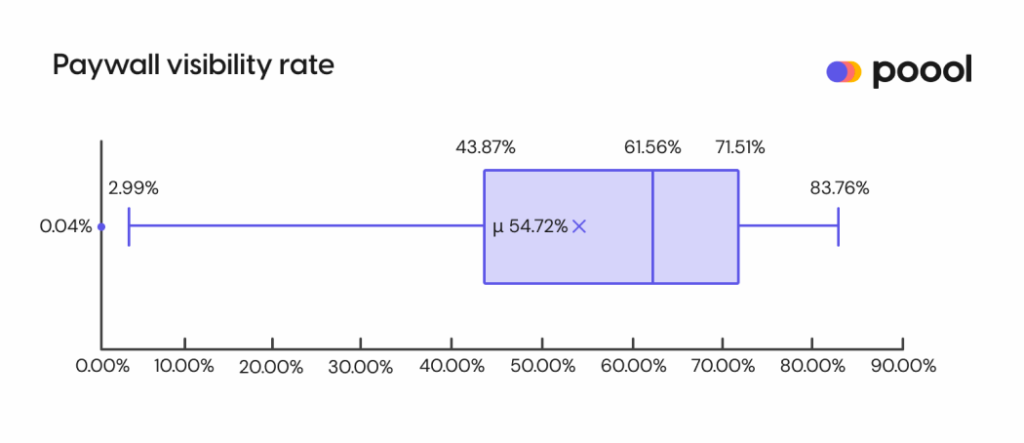
Similarly to the previous metric, we can see that publishers are employing increasingly stricter paywall models since before the pandemic – our 2020 benchmark study found an average of 30-60% paywall visibility rate, whilst this Q2 2023 report finds publishers lying between 43.87-71.51% on average.
We’re also seeing increasingly more publishers at the higher end of this range, particularly B2B and specialist media whose audience is more engaged and so likely to be less frustrated by a wall that blocks a higher percentage of content. Having said this, the large majority of publishers in this study still have significantly lower visibility rates than some of the most successful American and British publishers, who are arguably the most mature in their paywall models, are blocking >80% of content, with many examples of those at 100%, such as The Washington Post & Financial Times.
Importantly, this metric shouldn’t be considered as a question of how much of your content you’re blocking, rather how many potential subscribers are being lost at this stage because they never actually see the paywall? It’s not only a question of paywall ‘height’ but also of content and engagement.
How can you optimize this metric?
- The most effective: display a full-page wall covering all content, just like The New York Times, WP or FT. In this case, the reader only has to scroll a tiny bit (if at all) to see the paywall, and you’ll guarantee yourself 95-100% visibility. Obviously, if your business model depends partly on advertising, you’ll have to be careful not to hide your ads and damage revenue. It’s therefore not a hack suitable for everyone.
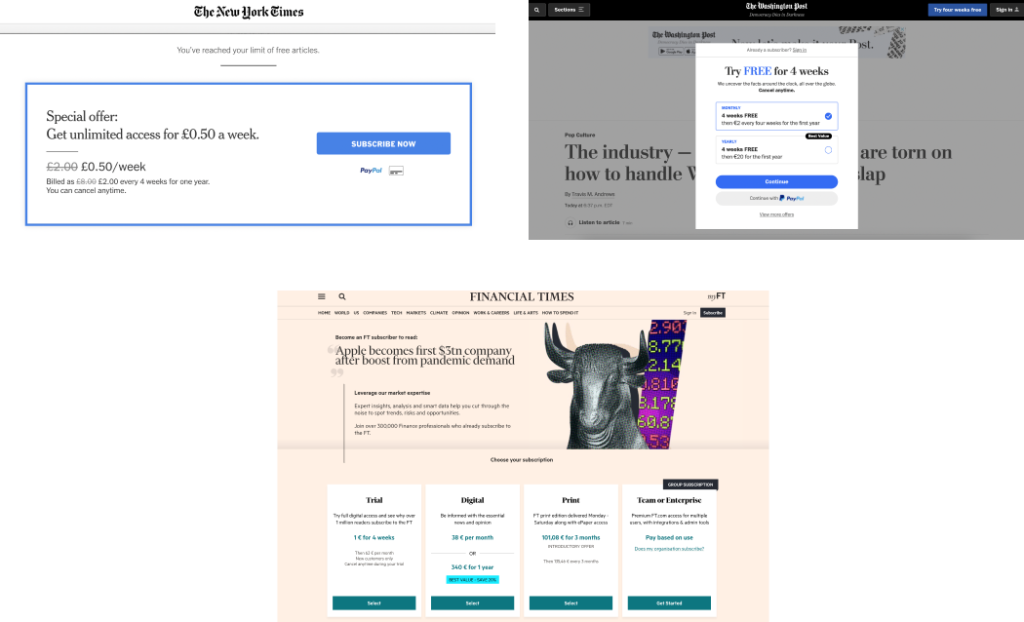
- The most risk-free: try moving the paywall further up the article. In most cases, paywalls are displayed after 20% of the content, or after the 2nd paragraph. So try reducing the amount of text available to read before the wall. One of our clients tested this strategy, increasing the percentage of text blocked by 10% (from 80% to 90% blocked) which led to a 3.9% increase in paywall visibility rate within 5 weeks.
- The most adaptable: let your editor choose where the wall will block! This allows them to integrate the paywall into their storytelling, adding the wall just before the cliff hanger to better encourage conversions. This is what Eric Le Braz calls The Hourglass Technique.
- The simple, essential thing to do: make sure your paywall load time is fast, and that it’s called early on, especially in relation to your ad scripts. Pre-upload, and optimize the weight of font and images.
Insights on paywall views:
“Increasing the number of times a reader hits a paywall makes them more likely to subscribe, but this trend eventually declines”
A study by Mather Economics considers the relationship between paywall views and conversion rate.
“Hitting the paywall boosts a reader’s propensity to subscribe, but after a peak, that propensity declines. For many publishers, propensity began to decline after 10 to 15 paywall hits, indicating the need for aggressive conversion tactics.
For readers hitting the paywall more than 15 times, alternative tactics can be used. These include offering registration, special discounts, different calls to action, value propositions and other targeted incentives. Mather enabled publishers to target these users by creating an audience segment – High Modal Users – that can be connected to the paywall and marketing tools. Varying the offers, discounts and calls to action can monetize the hard-to-subscribe users.”
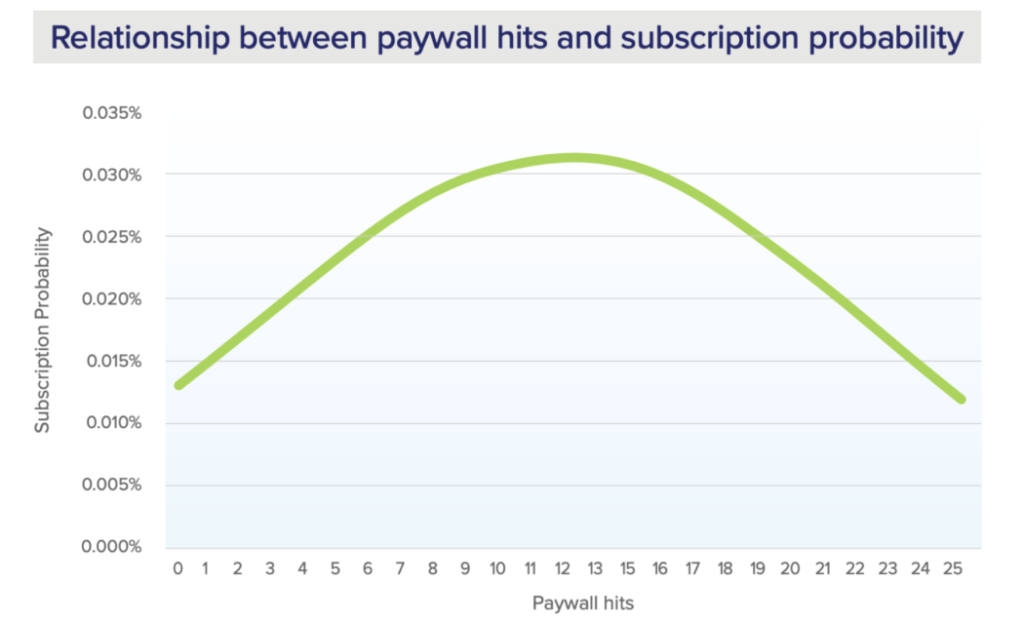
With this knowledge, how can we optimize conversion rates for users hitting the paywall 10-15+ times?
Consider creating a dedicated audience segment, building a dynamic experience adapted to their context…
- Varying the offers, e.g. a special starter discount to encourage conversion
- Adapted wording, perhaps an article count like The Guardian
- Present a registration wall to de-anonymize the user, increase engagement & collect data points to inform your strategy
Got any questions or thoughts to share on your own strategy and data? Get in touch with your account manager, we’d love to hear from you!
Step 3. Click-through rate (CTR)
Def. How many of these users who saw the paywall actually click on the “Subscribe” button?
Overall average: 2.56%
Range: 0.05%-22.5%
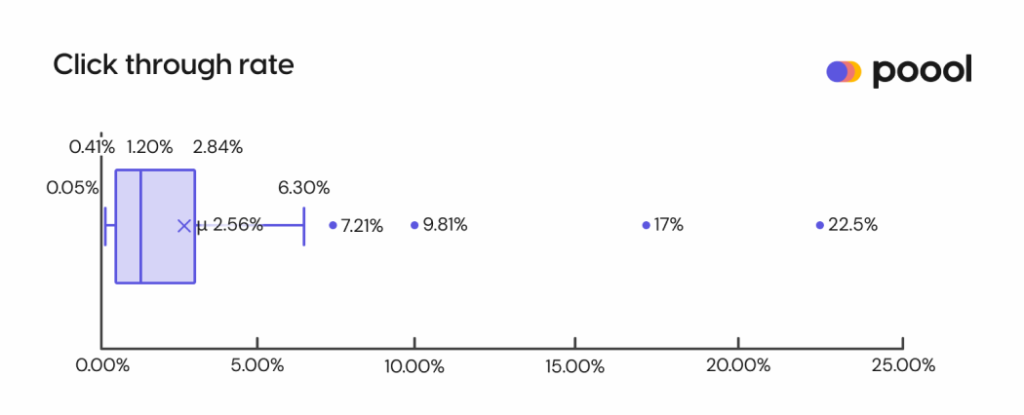
This graph successfully sums up the results that we’re finding for this stage in the funnel… There’s a lot of variation!
B2B publishers are by far the best performing in this metric, with an average CTR of 6.04%. However, it’s worth noting that this result is skewed slightly by a few very high click-through rates, notably the 22.5% and 17%.
To help make these results more valuable, the market average is around 0.2%, whilst the average CTR amongst Poool clients (who regularly update their wall, build dynamic walls for each audience segment and run A/B tests on wording, design & scenario) is more like 3%.
How can you optimize this metric?
It’s well known in the advertising industry that if we’re exposed to the same visual for too long, we become blind to it. It’s the same with your paywall, what we call paywall fatigue or paywall blindness. If your wall always looks the same, CTR will stagnate, then decrease. If, on the other hand, you regularly update your paywall, such as by altering the design or messaging, you’ll see a 15-100% increase in clicks in the weeks following.
The full report goes into more detail and shares case study examples from our clients. Download the PDF to share with your colleagues and compare with your own performance here.
Step 4. Conversion rate out of total clicks
Def. How many users who click-through your paywall end up paying to become a subscriber?
Overall average: 5%
Range: 0.01% – 12%

These conversion rates have already increased significantly since last quarter, where the average was at 1.7%.
Does this conversion benchmark seem low to you?
It’s because there’s a huge difference in performance between anonymous users and registered members (who are highly more engaged). And, when we look at the percentage of traffic in these two audience segments, we’ll see that more than 90% of users are anonymous and volatile with a low level of engagement. Hence the value of registration models and soft conversion steps prior to the paywall…
How can you increase this metric?
As mentioned throughout this report, when it comes to converting your audience into members or subscribers, it’s essential to find the perfect balance between frustration and engagement. But, like many things, it’s easier said than done….
Too much frustration and a user leaves your site to find content elsewhere.
Leave too much content open and you may well increase engagement but this won’t increase your revenues.
And, to complicate matters further, this ‘perfect balance’ is different for every publisher depending on the audience, content and strategy.
The key is therefore in soft conversion steps prior to the paywall that target less engaged users and help to move them through the funnel to both increase recency, frequency and volume of visits (engagement) and ARPU (average revenue per user) so as to maximize the potential revenue of each individual user, even if they are never going to pay to subscribe.
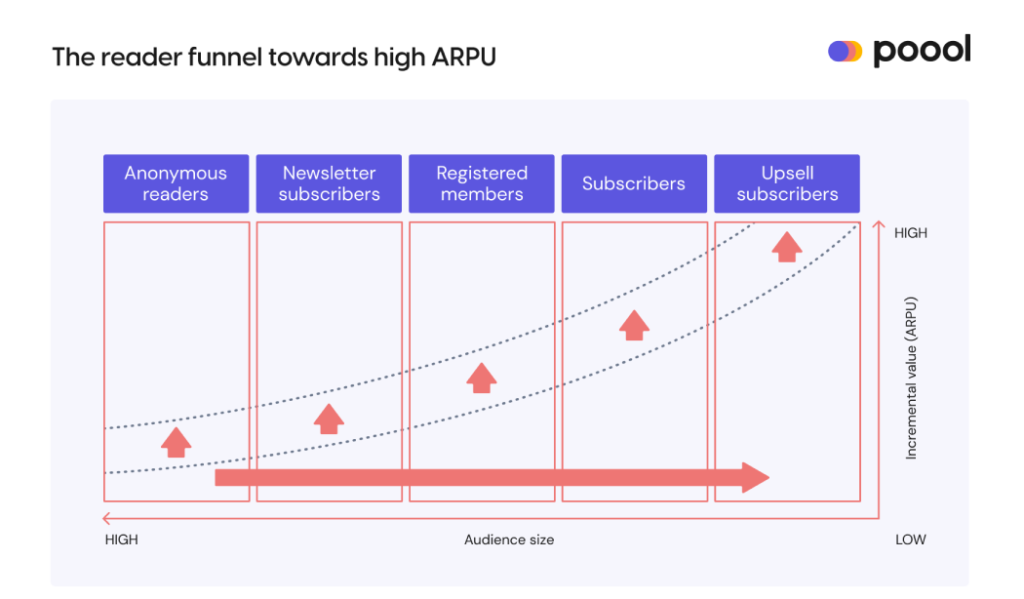
Soft conversion strategies:
There are two soft conversion steps that are the most valuable to increasing a user’s propensity to subscribe:
- Newsletter sign up
Newsletters can achieve a variety of goals, from habit formation, bringing the user back to read more of your content to increasing retention rates and building closer relationships with readers.
Best practice: consider a newsletter wall that asks readers to sign up to your newsletter in exchange for access to content. We do this on the Poool blog and on The Audiencers – it’s been a game changer for increasing the engagement of our audience!

- Registered (free) member
Logged users are highly more engaged than anonymous readers – they come back more frequently, consume more content, stay for longer and interact with your site thanks to the features they now have access to as a member, such as being able to read more articles, save content for later and share their opinion through commenting.
Thanks to this engagement, registration supports both ad and subscription revenue streams:
- Advertising – thanks to the first-party data and custom reader IDs, ad spots can be sold at a higher cost (targeted to a specific profile), and higher engagement means more eyes on more pages
- Subscription – registered users are highly more likely to subscribe, 13 times more at L’Équipe and 45 times at The Independent. They also have higher retention rates meaning a greater CLTV than your average subscriber

Bringing the funnel together:
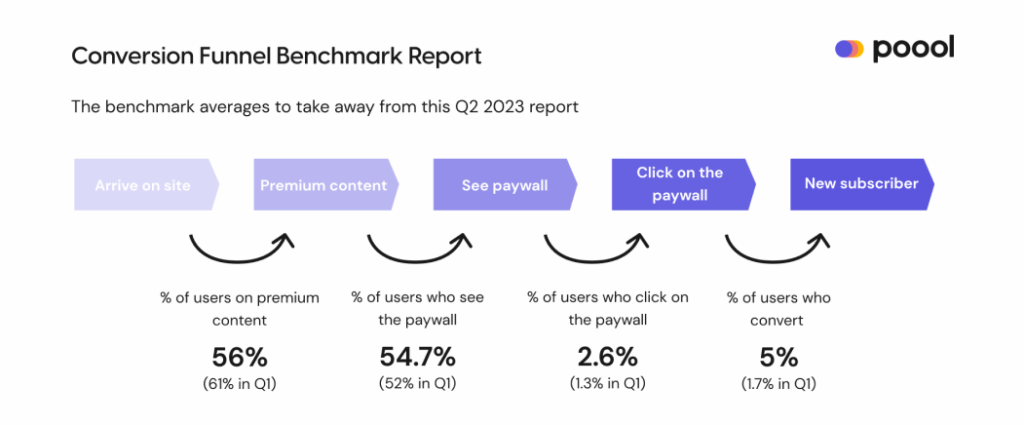
- Traffic arrives on a publisher’s site and an average of 56% move through to visit a premium article
- Out of these users, an average of 54.7% will see the paywall
- An average of 2.6% of users on premium content click on the paywall ‘Subscribe’ button
- And, finally, an average of 5% of this traffic convert into a subscriber (i.e. conversion rate = total paywall view / total clicks)
Why is this information valuable and what should you do with it?
Thanks to this broken-down conversion funnel, you can calculate and compare performance at each of the 4 steps, understanding exactly where you need to focus optimization efforts.
For instance, you may spend time and resources on optimizing paywall design, but in fact you’re losing the majority of your traffic at the first step – i.e. users are never actually moving through to a premium article where they have the chance to be exposed to the paywall. What’s the point in building a well-designed paywall if no one even sees it?
What you’ll also find is that even small improvements to each step will culminate into significant improvements to your overall user-to-subscriber conversion rates as increasing performance at one step naturally impacts the performance in the steps that follow. We’d recommend our article on The Audiencers to dive into this in more detail.
Download the report in full here.
You have the tools, but what about the expertise? Our consultancy team is here to help!
- An extra pair of hands to support your team in the operational, daily Dashboard tasks
- A consultant already working with a variety of publishers facing similar problems, who knows the solutions that get the best results
- Confidence in guaranteeing an ROI from your investment in Poool’s solution
- A set rhythm: a defined roadmap that we’ll keep coming back to, putting strategies in place to achieve your targets
Speak to your account manager to learn more & get a free consultancy session.





